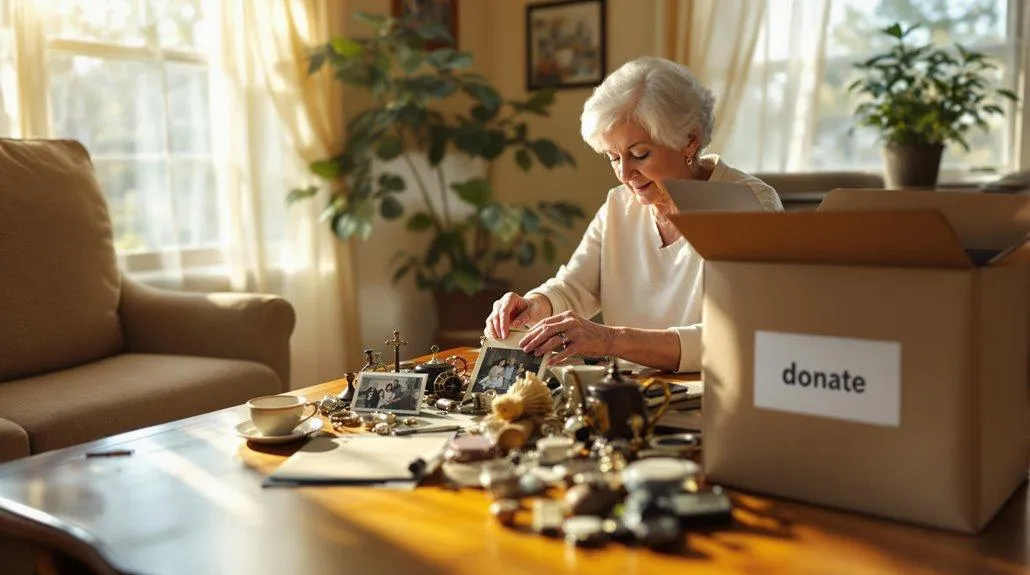
Letting Go of Sentimental Items From Your NJ Home: Tips for Seniors
Letting go of sentimental items from your NJ home can feel overwhelming, especially when those belongings are tied to cherished memories. It’s essential to recognize the emotional weight of each item while also acknowledging the benefits of decluttering. By setting realistic goals and utilizing effective sorting strategies, you can navigate this process with greater ease. As you begin to reflect on how to preserve memories without the physical clutter, you might find surprising alternatives that honor your past.
Key Takeaways
Acknowledge the emotional attachment to items and reflect on their significance before making decisions on retention.
Set realistic decluttering goals by breaking tasks into smaller, manageable areas and establishing a timeline.
Categorize items into “Keep,” “Donate,” and “Discard” to clarify decisions and reduce overwhelm.
Explore creative memory preservation methods, like photo books or memory jars, to honor the past without keeping physical items.
Seek support from friends, family, or professionals to gain perspective and ease the emotional process of letting go.
Understanding the Emotional Attachment to Keepsakes

When you hold onto a keepsake, it’s often more than just a piece of material; it’s a vessel of memories and emotions that can evoke deep connections to your past.
These items may remind you of cherished moments, loved ones, or significant milestones, making it tough to part with them. You might feel a sense of security in their presence, believing they anchor you to your identity and history.
This emotional attachment can sometimes cloud your judgment, leading you to keep items well beyond their practical use. Recognizing the feelings tied to your keepsakes is essential.
Setting Realistic Goals for Decluttering
Establishing realistic goals for decluttering can greatly ease the emotional burden of letting go of sentimental items.
Start by identifying specific areas in your home that need attention, such as a closet or a room filled with keepsakes. Break down your decluttering process into manageable tasks, setting a timeline to complete each one. For example, aim to sort through one box or drawer per week.
It’s important to focus on quality over quantity; prioritize the items that truly hold meaning for you. Celebrate small victories along the way, as this can motivate you to continue.
Strategies for Sorting and Categorizing Items

Sorting and categorizing your sentimental items can transform what often feels like an overwhelming task into a systematic approach that makes decision-making easier.
Start by creating categories like “Keep,” “Donate,” and “Discard.” As you go through each item, ask yourself if it holds significant meaning or if it represents a memory you cherish.
Consider using boxes or bins to separate your categories, which can help keep the process organized. You might also find it helpful to set a timer and work in short bursts, allowing you to focus without feeling rushed.
Finally, don’t hesitate to enlist a friend or family member for support; their perspective can offer valuable insights and keep you motivated as you sort through your belongings.
Creative Ways to Preserve Memories
While sentimental items often bring emotions to the surface, finding creative ways to preserve those cherished memories can help you keep the essence of what they represent without the clutter.
Sentimental items evoke strong emotions, but creative preservation methods can capture their essence without the clutter.
Here are three innovative ideas to contemplate:
Memory Jar: Collect small notes or mementos from special occasions, and place them in a jar. This allows you to revisit those moments anytime you want.
Photo Books: Compile your favorite photos into a beautifully designed photo book. This not only saves space but also creates a stunning keepsake.
Fabric Projects: Transform beloved clothing items into quilts or pillows. This way, you can enjoy the memories in a functional form.
These methods let you honor your past while freeing up physical space in your home.
Seeking Support During the Decluttering Process

Letting go of sentimental items can be a challenging journey, and seeking support during the decluttering process can make all the difference. You don’t have to do it alone; enlist family members or friends who understand your attachment to these items. They can provide fresh perspectives, helping you decide what to keep and what to let go of.
Additionally, consider joining a local support group or hiring a professional organizer who specializes in assisting seniors. Sharing your feelings with others who relate can ease the emotional burden.
Frequently Asked Questions
What Are the Benefits of Decluttering for Seniors?
Decluttering offers numerous benefits for seniors, enhancing both physical and mental well-being.
By clearing out unnecessary items, you create a safer living environment, reducing the risk of falls and accidents. It also fosters a sense of control and accomplishment, as you take charge of your space.
Additionally, a tidy home can alleviate stress and anxiety, making daily tasks feel more manageable.
Ultimately, this process can lead to a more enjoyable, fulfilling lifestyle.
How Can I Involve My Family in the Process?
To involve your family in the decluttering process, start by scheduling a family meeting to discuss the importance of the task.
Invite them to share their thoughts on what items hold value or significance.
Encourage collaboration by assigning specific areas or categories for each member to tackle. This not only makes the process more manageable but also strengthens bonds as you reminisce together.
Finally, appreciate their efforts to create a more organized space.
What Should I Do With Items I Cannot Part With?
If you can’t part with certain items, consider preserving them in a more manageable way. You might take photos or create a scrapbook to honor memories without keeping everything.
Alternatively, think about designating a display area in your home for these cherished items. This way, you can enjoy them daily without feeling overwhelmed.
Finally, consider sharing stories behind the items with family, ensuring their significance continues even if the physical objects don’t.
Are There Local Charities That Accept Sentimental Donations?
Yes, there are several local charities that accept sentimental donations.
Organizations like Goodwill and Salvation Army often welcome items like clothing, furniture, and household goods.
Additionally, local shelters or community centers may appreciate unique items that can be used to support their programs.
Before donating, check with the charity to see what they specifically need, ensuring your items find a new home where they can continue to bring joy to others.
How Do I Handle Guilt About Letting Go of Items?
Handling guilt about letting go of items can be challenging. Start by acknowledging your feelings; it’s normal to feel attached.
Try focusing on the memories those items represent rather than the items themselves. Consider taking photos of them to preserve their essence.
Donating or giving items to loved ones can also ease guilt, as it allows you to share your memories.
Bottom Line
Letting go of sentimental items can be a difficult journey, but it’s an essential step toward creating a more organized and peaceful living space. By understanding your emotional attachments and employing effective strategies, you can make this process manageable. Remember, preserving memories in creative ways allows you to honor your past while minimizing clutter. Seek support from family and friends, celebrate your progress, and embrace the freedom that comes with making thoughtful decisions about your belongings.


